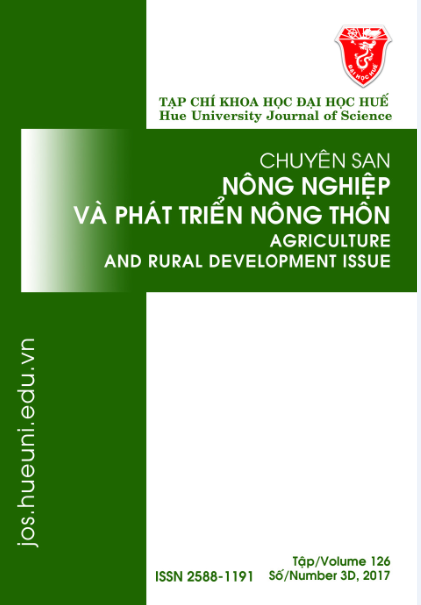Tóm tắt
Tóm tắt: Với mục đích tìm kiếm các loài vi khuẩn lam có tiềm năng sản sinh các hợp chất hoạt tính sinh học, chúng tôi trình bày kết quả phân lập, xác định thành phần loài vi khuẩn lam (VKL) từ đất ruộng lúa huyện Phú Vang – Thừa Thiên Huế và thăm dò khả năng kháng khuẩn, kháng nấm của chúng. Đã thu thập được 22 loài vi khuẩn lam thuộc 2 bộ (Nostocales và Oscillatoriales), 3 họ (Nostocaceae, Rivulariaceae và Oscillatoriaceae) và 6 chi (Anabaena, Cylindrospermum, Nostoc, Calothrix, Oscillatoria và Phormidium). 20 chủng VKL được phân lập và duy trì ổn định trong môi trường nhân tạo. 12 chủng được làm sạch khuẩn và xác định hoạt tính kháng vi sinh vật của dịch chiết của chúng đối với Bacillus subtilis, Staphylococcus aureus, Escherichia coli và Candida albicans, trong số đó 9 chủng kháng Bacillus subtilis, 9 chủng kháng Staphylococcus aureus, 5 chủng kháng Escherichia coli, 5 chủng kháng nấm Candida albicans. Chủng có hoạt tính cao nhất và cũng là chủng kháng được cả 3 loại VSV kiểm định là chủng HN42 của loài Nostoc muscorum với đường kính vòng kháng từ 4,5 đến 9,0 mm.
Từ khóa: vi khuẩn lam, đa dạng, kháng khuẩn, kháng nấm, dịch chiết
Tài liệu tham khảo
- Đoàn Đức Lân, Nguyễn Đình Quyến, Dương Đức Tiến, Nguyễn Kim Vũ (1994), Kết quả nghiên cứu VKL cố định nitơ ở lúa vùng đất mặn huyện Thái Thụy, Tạp chí khoa học – Công nghệ và quản lý kinh tế, 6, 217–218.
- Dương Đức Tiến (1994), Vi khuẩn lam cố định nitơ trong ruộng lúa, Nxb. Nông nghiệp, Hà Nội.
- Dương Đức Tiến (1996), Phân loại vi khuẩn lam ở Việt Nam, Nxb. Nông Nghiệp, Hà Nội.
- Bauer A. W., Kirby W. M., Sherris J. C., Turck M. (1996), Antibiotic susceptibility testing by a standardized single disk method, American Journal Clinical Pathology, (45), 493 –496.
- Desikachary T. V. (1959), Cyanophyta, Indian council of agricultural reseach, New Delhi.
- Digamber Rao (2015), Antibacterial activity of fresh water Cyanobacteria, Journal of Algal biomass Utilization, 6(3), 60–64.
- Hazarika D., Duarah I., Barukial J. (2012), An ecological assessment of algal growth with particular reference to blue-green algae from upper Brahmaputra valley of Assam, Indian Journal of fundamental and applied life science, 2(3), 29–35.
- Komárek J. and Anagnostidis K. (1999), Cyanoprokaryota 1. Teil: Chroococcales, Gustav Ficher Verlag Jena, 548.
- Kotai J. (1972), Instructions for preparation of modified nutrient solution Z8 for algae, Norwegian Institute for Water Research, Oslo B-11 (69), 1–5.
- Patra J. K., Rath S. K., Jena K., Rathod V. K., Thatoi H. N. (2008), Evaluation of antioxidant and antimicrobial activity of seaweed (Sargassum sp.) extract: A study on inhibition of Glutathione - Stransferase activity, Turkish Journal of Biology, 32, 119–125.
- Rodriguez A. A., Stella A. A., Storni M. M., Zulpa G., Zaccaro M. C. (2006), Effects of cyanobacterial extracelular products and gibberellic acid on salinity tolerance in Oryza sativa L, Saline Systems, 2– 7.
- Selvi K. V., Sivakumar T. (2012), Isolation and characterization of silver nanoparticles from Fusarium oxysporum, International Journal of Current Microbiology and Applied Sciences, 1, 56 –62.
- Shariatmadari Z. and Riahi H. (2013), A taxonomic study on soil taxa of apoheterocytic cyanoprokaryota from Nostocaceae family in Iran, The Iranian Journal of Botany, 19(2), 143–152.
- Singh S. S., Kunui K., Minj R. A., Singh P. (2014), Diversity and distribution pattern analysis of cyanobacteria isolated from paddy fields of Chhattisgarh, Indian Journal of Asia-Pacific Biodiversity, 7, 462–470.
- Tuney I., Cadirci B. H., Unal Dand, Sukatar A. (2006), Antimicrobial activities of the extracts of marine algae from the coast of Urla (Izmir, Turkey), Turkish Journal of Biology, 30, 171–175.
- Vijayakumar S., Deepa P., Jeyachandran S., Manoharan C., Madhumathi V. (2011), Antimicrobial Activity of Cyanobacteria Isolated from Freshwater Lake, International Journal of Microbiological Research, 2(3), 213–216.
- Whitton B.A., Potts M. (2000), The ecology of cyanobacteria, Kluwer Dordrecht, the Netherlands, 233–255.
